The Present
Today, robotic
components fill our homes. Many Robots entertain children, some
help with the household, and others even guard our houses. The
function of the modern home relies completely on the help of robotics.
The following are examples of robots in today's world.
The Hug[12]
Robotics researchers in Pittsburgh have designed
a soft, huggable, robotic pillow that uses sensing and wireless
phone technology to provide a physical touch. The pillow, called
the Hug, was developed after the researchers studied how robotics
could improve 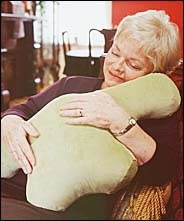 products
the elderly use every day. The Hug, which is about the size of
a throw pillow but as firm as a seat cushion, is shaped like a
person about to give a hug, with two arms reaching up and out.
The outside is covered in velour, making it soft and comfortable.
products
the elderly use every day. The Hug, which is about the size of
a throw pillow but as firm as a seat cushion, is shaped like a
person about to give a hug, with two arms reaching up and out.
The outside is covered in velour, making it soft and comfortable.
To send a hug, a person would squeeze the left paw of his/her
device and speak another person’s name into a microphone
in the top of the pillow. Voice recognition software in the processor
in the device identifies the name and matches it to a preset phone
number corresponding to the other Hug. That person’s Hug
calls the other person’s, which lights up and plays sounds.
To accept the hug, he/she squeezes the left paw and says hello,
opening a direct voice link between the two people. The hug is
ended by pressing the right paw and saying goodbye.
If someone is not home to receive a hug, the other person can
leave a message that includes voice and vibration patterns. The
Hug can store up to four messages.
Unlike a regular phone, for which wrong numbers are a way of life,
there is no need to fear getting a hug in error. Each person you
would want to hug has to be added to your network, much like a
cell phone is programmed with personalized rings. (12)
The Roomba[2]
The Roomba is a housecleaning robot built by iRobot.
It was the first robot ever built 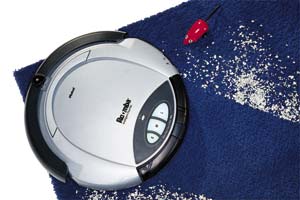 that
is designed to live in your home, do something useful, and be
priced for the mass market. The Roomba is designed to vacuum a
room without any help from a human or any other robot. The Roomba
is controlled by heuristics that map the size of the room and
the obstacles in its path. The Roomba roams around the room and
lightly bumps into other household objects.
that
is designed to live in your home, do something useful, and be
priced for the mass market. The Roomba is designed to vacuum a
room without any help from a human or any other robot. The Roomba
is controlled by heuristics that map the size of the room and
the obstacles in its path. The Roomba roams around the room and
lightly bumps into other household objects.
Because of the Roomba’s circular shape, it cannot reach
corners of the room, and leaves a little dirt in those corners.
Also, if the couch, bed, or other piece of furniture is high enough,
it has the possibility of getting stuck under it. After the Roomba
covers the room many times, it beeps and shuts down. The Roomba
costs $199, which is about the price of a mid-range vacuum cleaner.
It is 5lb and 10oz, has limited vision, and is only 13.5 inches
wide.
There are hopes that one day Roomba will do for vacuuming what
dishwashers did for dishwashing.[2]
Automower[13]
The Automower is made by Husqvarna and is designed
to save time and make life easier. It can handle up to 1,800 square
meters. Once the boundaries of a lawn are set with a perimeter
wire system, Automower can be trusted to wander off on its own
continuously mowing rain or shine, twenty-four hours a day, seven
days a week, recharging itself as needed. The Automower cuts the
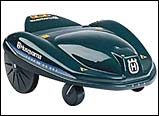 grass
neatly and fertilizes as it mows because short clippings drops
back onto the lawn. The Automower is safe to leave running around
animals because it can sense the objects and animals around it.
The Automower can be programmed to run continuously or during
certain hours of the day. Automowers use about the same amount
of electricity as a 15-watt light bulb, and is quieter than the
typical volume of a television. The Automower weights 15.6 lbs
(7.1 kg), has a length of 28 inches (710mm), has a width of 23.6
inches (660mm), and has a height of 10.2 inches (260 mm). Automower
is a bit pricey, costing $1,500 to $2,000.
grass
neatly and fertilizes as it mows because short clippings drops
back onto the lawn. The Automower is safe to leave running around
animals because it can sense the objects and animals around it.
The Automower can be programmed to run continuously or during
certain hours of the day. Automowers use about the same amount
of electricity as a 15-watt light bulb, and is quieter than the
typical volume of a television. The Automower weights 15.6 lbs
(7.1 kg), has a length of 28 inches (710mm), has a width of 23.6
inches (660mm), and has a height of 10.2 inches (260 mm). Automower
is a bit pricey, costing $1,500 to $2,000.
If the Automower runs for sixteen hours, it spends half of that
time recharging. The Automower occasionally has trouble with steep
hills, but can usually pick itself up fairly quickly. With the
Automower, no one has to worry about mowing the grass anymore.
Wakamaru[4]
The Wakamaru is the first human-size robot that
can provide companionship, or function as a caretaker and house
sitter. The Wakamaru was created in Japan, and will be for sale
there for about one million yen ($14,250). The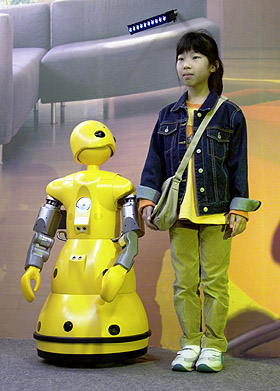 Wakamaru moves around on wheels, is 3.3 feet tall, weighs 60 pounds,
and recharges itself when batteries run low.
Wakamaru moves around on wheels, is 3.3 feet tall, weighs 60 pounds,
and recharges itself when batteries run low.
The Wakamaru can be programmed to call or e-mail a designated
person, hospital, or security firm if it notices a problem. It
features continuous access to the Internet, and is equipped with
voice and face recognition capabilities that allow the robot to
search for and follow faces and movement. It has the ability to
comprehend and interact with humans, and also comes with a built-in-dictionary,
making it able to recognize 10,000 words.
The Wakamaru promises to be an ideal help for elderly people,
the disabled, or others that are living independently.[4]
My Spoon, and the Internation Robot Convention[14]
The robot, My Spoon, is one that can help feeding
disabled people. This robot helps 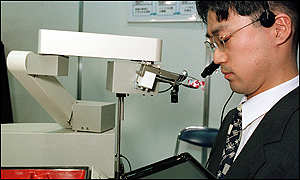 around
the house and comes in handy when there are disabled family members.
This robot debuted in the International Robot Exhibition in Tokyo,
Japan. Some other robots included a robot that imitates a butler.
It can pour out wine and talk to guests. Even another robot was
one that delivered meals to hospital patients.
around
the house and comes in handy when there are disabled family members.
This robot debuted in the International Robot Exhibition in Tokyo,
Japan. Some other robots included a robot that imitates a butler.
It can pour out wine and talk to guests. Even another robot was
one that delivered meals to hospital patients.
Problems
There are many challenges that face researchers
trying to build intelligent household robots. Among these are[1]:
1. It is very difficult to build a robot capable
of navigating the contantly changing terrain of a house.
2. Supplying power to the robot can be challenging.
3. The current state of AI makes robot behavior
unreliable.
4. Safety issues, robots that are capable of heavy
lifting and other tasks can be a danger to people in their home.
5. Machines built to overcome obstacles 1-4 can
become extremely expensive and out of reach of the common consumer.
We believe the future of household robotics lies
in our MAID System.


 products
the elderly use every day. The Hug, which is about the size of
a throw pillow but as firm as a seat cushion, is shaped like a
person about to give a hug, with two arms reaching up and out.
The outside is covered in velour, making it soft and comfortable.
products
the elderly use every day. The Hug, which is about the size of
a throw pillow but as firm as a seat cushion, is shaped like a
person about to give a hug, with two arms reaching up and out.
The outside is covered in velour, making it soft and comfortable. that
is designed to live in your home, do something useful, and be
priced for the mass market. The Roomba is designed to vacuum a
room without any help from a human or any other robot. The Roomba
is controlled by heuristics that map the size of the room and
the obstacles in its path. The Roomba roams around the room and
lightly bumps into other household objects.
that
is designed to live in your home, do something useful, and be
priced for the mass market. The Roomba is designed to vacuum a
room without any help from a human or any other robot. The Roomba
is controlled by heuristics that map the size of the room and
the obstacles in its path. The Roomba roams around the room and
lightly bumps into other household objects. grass
neatly and fertilizes as it mows because short clippings drops
back onto the lawn. The Automower is safe to leave running around
animals because it can sense the objects and animals around it.
The Automower can be programmed to run continuously or during
certain hours of the day. Automowers use about the same amount
of electricity as a 15-watt light bulb, and is quieter than the
typical volume of a television. The Automower weights 15.6 lbs
(7.1 kg), has a length of 28 inches (710mm), has a width of 23.6
inches (660mm), and has a height of 10.2 inches (260 mm). Automower
is a bit pricey, costing $1,500 to $2,000.
grass
neatly and fertilizes as it mows because short clippings drops
back onto the lawn. The Automower is safe to leave running around
animals because it can sense the objects and animals around it.
The Automower can be programmed to run continuously or during
certain hours of the day. Automowers use about the same amount
of electricity as a 15-watt light bulb, and is quieter than the
typical volume of a television. The Automower weights 15.6 lbs
(7.1 kg), has a length of 28 inches (710mm), has a width of 23.6
inches (660mm), and has a height of 10.2 inches (260 mm). Automower
is a bit pricey, costing $1,500 to $2,000. Wakamaru moves around on wheels, is 3.3 feet tall, weighs 60 pounds,
and recharges itself when batteries run low.
Wakamaru moves around on wheels, is 3.3 feet tall, weighs 60 pounds,
and recharges itself when batteries run low. around
the house and comes in handy when there are disabled family members.
This robot debuted in the International Robot Exhibition in Tokyo,
Japan. Some other robots included a robot that imitates a butler.
It can pour out wine and talk to guests. Even another robot was
one that delivered meals to hospital patients.
around
the house and comes in handy when there are disabled family members.
This robot debuted in the International Robot Exhibition in Tokyo,
Japan. Some other robots included a robot that imitates a butler.
It can pour out wine and talk to guests. Even another robot was
one that delivered meals to hospital patients.